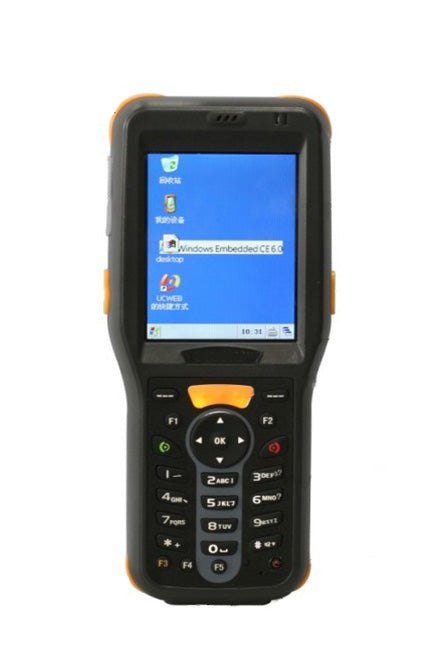
How to choose a PDA/data collector?
How to choose a data collector?
First, we need to understand what a portable data collector is. According to the different uses of data collectors, they can be roughly divided into two categories: online data collectors and portable data collectors. The on-line data collector can be divided into desktop and connection type. Most of them are directly powered by the AC power supply. Generally, they are not used independently. Data is transmitted between the collector and the computer through the cable connection. It cannot be used offline. There are generally two ways in which the scanner transmits data to the computer: one is keyboard emulation; the other is transmitting data to the computer through the communication port. For the former, there is no need for separate power supply, and the power is derived from the inside of the computer; the latter requires separate power supply. Therefore, the on-line data collector must be installed in a fixed location, and the bar code symbol must be read before the scanner. At present, some logistics companies have begun to use them in their warehouse management. Due to the limitations of the scope and use of online data collectors, they cannot be used in applications that require off-line use, such as stock counting, scanning of large items, etc. In order to make up for the inadequacies of online data collectors, portable data collectors came into being.
The portable data collector is designed to adapt to some field data acquisition and scanning bar code symbols for bulky objects and is suitable for off-line use. When reading, contrary to the on-line data collector, it scans the scanner before it is brought to the bar code symbol. Therefore, it is also referred to as a hand-held terminal and a checkout machine. It consists of electricity
The pool power supply, communication with the computer does not and sweep
The tracing is performed at the same time. It has its own internal memory, can store a certain amount of data, and can transmit this data to the computer when appropriate. Almost all portable data collectors have a certain degree of programming ability, and when coupled with an application program, they can become very powerful special-purpose devices, which can meet the application needs of different occasions. More and more logistics companies have turned their attention to portable data collectors. Some logistics companies in China have used portable data collectors for warehouse management, transportation management, and item tracking.
At present, there are thousands of manufacturers engaged in the development, research, and production of bar code technologies and their products in various countries in the world. There are nearly 10,000 varieties of products, and portable data collectors capable of storing tens of thousands of bar code information have been introduced. Used in warehouse management, inventory, and various field operations. Portable data collectors benefit from the development of electronic technology and continue to develop in the direction of miniaturization, miniaturization, and intelligence. Some portable data collectors sold in today's market are actually full-function computers, and some portable data collectors are small enough to fit into shirt pockets.
According to a recent report from the United States management consulting firm Zao Investment Development Corporation (VDC), sales of portable data collectors and services in the US market were $1.5 billion in 1995 and it is forecasted that this business will be 11% annual growth rate. Portable data collectors, their performance, configuration and data communications, and other technical indicators have greatly improved, with a new attitude toward the mall, and began to develop into a deeper, broader field. Especially in the field of electronic inventory (inventory) applications, foreign countries have achieved very good results and have been rapidly promoted.
With the widespread promotion of bar code technology, the modernization of shopping malls in China has developed rapidly and the level of electronic business management has been greatly improved. The market for portable data collectors has been formed and there is a great demand. However, the inventory of domestic logistics companies (inventories) is still at a relatively low level, and there is a big gap with the level of foreign business management. In fact, the application of data acquisition system can not only save time, reduce workload, reduce management costs, effectively improve the inventory structure, but also in the logistics company to establish a data acquisition system, the use of portable data collector is also very feasible.
- Difficult to implement
Logistics companies only need to purchase a portable data acquisition system on the basis of the original MIS system, without the need for a major move. With the development of science and technology, the functions of portable data collectors are increasingly perfected. General systems are provided with application software so that users can connect with the original system, and will not cause loopholes in the operation of the enterprise and the operation of the original system. It can be said that the use of a portable data collector is a useful supplement to the original system in inventory (inventory).
- Easy installation, simple operation and strong applicability
It does not need to increase the site, and is not limited by time and space. It is dexterous and practical, and facilitates the realization of inventory (inventory) and item tracking management.
- Equipment investment
The capital is not high but the effect is remarkable
For example, improve work efficiency, save work hours, and reduce manual work
Quantity, reduce various management expenses, improve inventory structure and so on. The most important thing is that using a portable data collector can shorten the inventory cycle and the time spent on each inventory, truly achieve non-stop inventory, and minimize the mistakes of site management.
- At present, there are many successful examples that can be used at home and abroad. The development of management and technology is relatively mature.
The application software of various types of portable data acquisition systems on the market has strong practicability, easy operation and good stability, and effectively improves the accuracy of inventory data and the reliability of data communication, and solves the disadvantages of slow and error-prone manual inventory.
- Easy to buy and maintain
Some foreign professional companies have set foot in the high-tech markets in the domestic commercial and logistics fields, such as Symbol and Zebra, Honeywell, etc., forming a relatively fierce buyer's market. This undoubtedly provides logistics companies with many conveniences: easy to buy, easy to maintain, easy to upgrade, and easy to enjoy after-sales service...
- Portable data collectors continue to be miniaturized, intelligent, and multifunctional
After the company purchases the equipment, the operator can quickly master the use, without special training or hiring professionals in this field.
With the promotion of bar code technology, the proportion of general-purpose commodity bar codes has been increasing year by year, and the application of logistics bar codes has become more and more extensive. All this has provided sufficient data sources for logistics companies to ensure the smooth use of portable data acquisition systems.
At present, there are dozens of portable data collectors on the domestic market, and their performance, specifications, and prices are different. This can be confusing for users. It is better to know which one to buy. For example, a portable data collector that also uses a 16-bit CPU will have similar performance and code compatibility, similar memory, display, and scanner configurations. When technical support and services are not much different, then for most users, Why spend thousands of dollars on prices that can be purchased for a few thousand dollars?
For the average user, the basic principles for choosing a portable data collector are:
(1) Applicable scope
Users should choose different portable data collectors according to their own different situations. If the user is using a portable data collector in a large-scale, three-dimensional warehouse, due to the high storage location of some items and the distance from the operator, we should choose a large depth of field, a long reading distance and a high first reading rate. Collector. For users of small and medium-sized warehouses, the requirements in this area are not very high, and you can choose some collectors with complete functions and easy operation. For the user to choose a portable data collector, the most important point in the selection is “enough to use”, that is, the purchase is applicable to their own needs, rather than blindly purchasing an expensive, powerful acquisition system.
(2) Decoding range
The decoding range is an important indicator for selecting a portable data collector. Every user has his or her own barcode code range. Most portable data collectors can recognize several codes or even dozens of different code systems such as EAN codes and UPC codes.
Big difference. In the application of logistics enterprises, we must also consider EAN128, 39, Kudaba, etc. Therefore, the user must fully consider his actual application when purchasing
The range of coding to select the appropriate collector.
(3) Interface requirements
The interface capability of the collector is another important indicator for evaluating its function, and it is also a key consideration when selecting the collector. When purchasing, the user must first clarify the operating environment and interface mode of the original system, and then select a portable data collector that adapts to the operating environment and interface.
(4) Requirements for first reading rate
The first reading rate is a comprehensive indicator of the data collector. It has a certain relationship with the print quality of the bar code symbol, the design of the decoder and the performance of the scanner. The higher the first reading rate, the more time-saving work time, but correspondingly, its price is also necessarily higher than other portable data collectors. In the inventory (inventory) of an item, the bar code symbol can be manually controlled to be repeatedly scanned with a portable data collector. Therefore, the requirement for the first reading rate is not strict, and it is only a measurement of work efficiency. However, in the automatic delivery system, the requirement for the first reading rate is high. Of course, the higher the first-read rate of the portable data collector, it will inevitably lead to an increase in its bit error rate. Therefore, when the user selects the collector, he must purchase a collector that meets the system requirements according to his own actual situation and economic ability. Both the rate and the error rate are balanced.
(5) Prices
When choosing a portable data collector, its price is also a concern. Because of the different configurations and different functions of portable data collectors, the price will vary greatly. Therefore, in the purchase of collectors should pay attention to the product's performance to price ratio, in order to meet the application system requirements and the lower price for the purchase of objects, truly "affordable."



